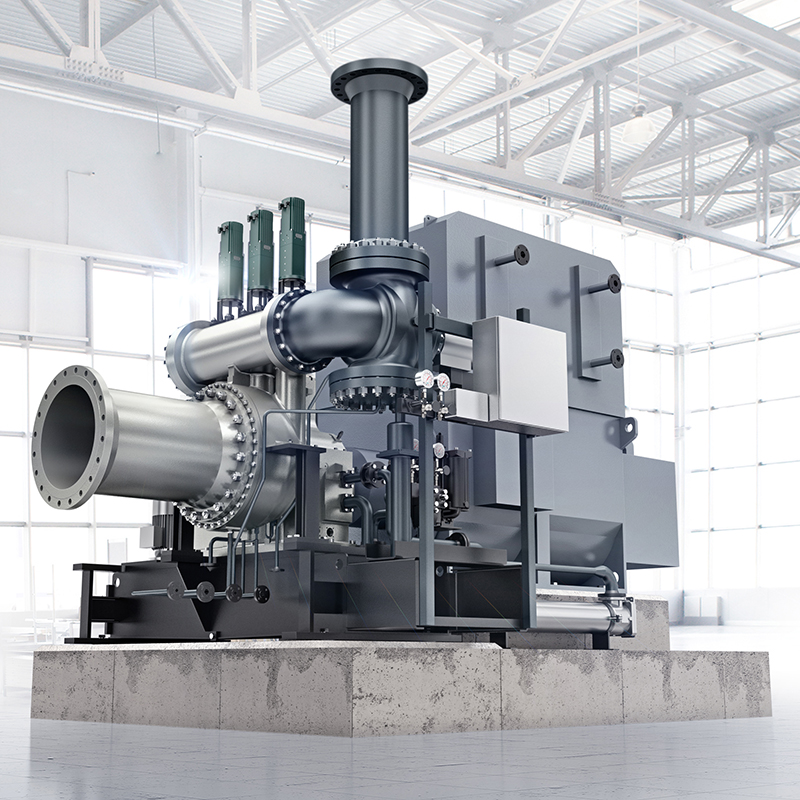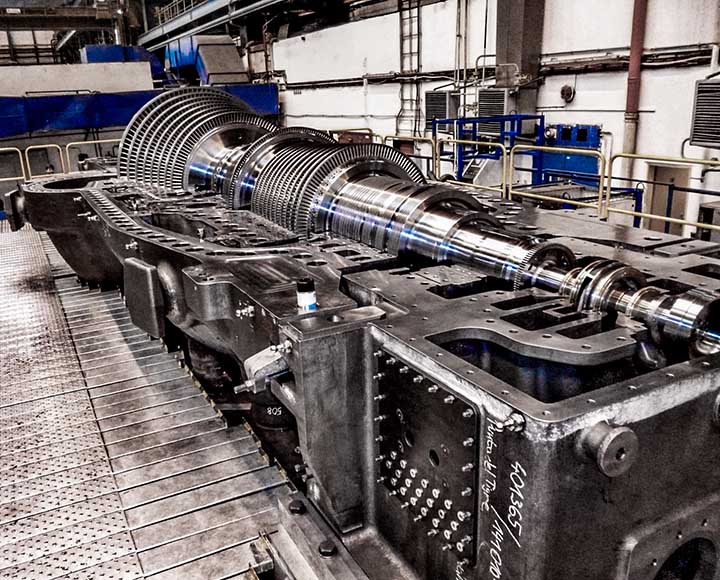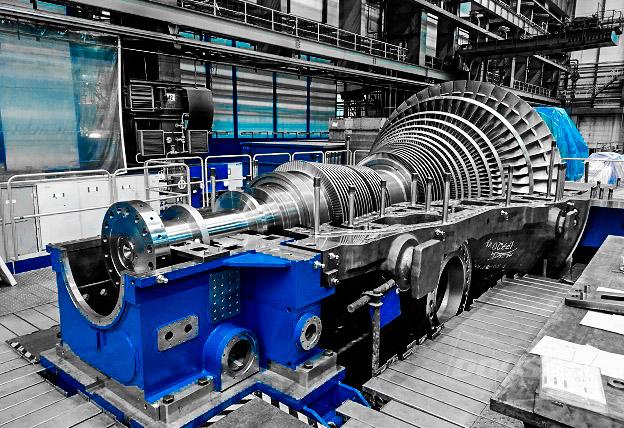BETTER MATERIALS FOR CASINGS, ROTORS, BLADES & NOZZLES IN STEAM TURBINES

LIMITATIONS IN ENGINEERING & DESIGN FOR MATERIALS IN CASINGS, ROTORS, BLADES & NOZZLES
When it comes to improving or selecting better materials in casings, blades, nozzles, rotors, and other components of special steam turbines, there are several limitations in engineering and design that need to be considered. These limitations include:
- Material Properties:
- High Temperatures: Special steam turbines operate under high temperatures, which limit the choice of materials that can withstand these conditions without experiencing deformation or failure.
- Corrosion Resistance: Steam turbines may be exposed to corrosive environments due to the presence of steam and various impurities. The materials used should have excellent corrosion resistance to ensure long-term reliability.
- Fatigue Strength: Components in steam turbines are subjected to cyclic loading, which can cause fatigue failure over time. Materials with high fatigue strength are desirable to withstand these conditions.
- Compatibility with Operating Conditions:
- Steam Quality: The quality of steam, including its temperature, pressure, and moisture content, can impact the material performance. The selected materials should be compatible with the specific steam conditions present in the turbine.
- Dynamic Loading: Components such as blades and rotors experience dynamic loading due to rotational forces. Materials should possess sufficient strength and stiffness to withstand these dynamic loads without deformation or failure.
- Manufacturing Constraints:
- Machinability: The chosen materials should be easily machinable to enable efficient manufacturing processes and to achieve the desired dimensions and tolerances for the turbine components.
- Weldability: Welding is often involved in the fabrication of turbine components. Material selection should consider the weldability and compatibility of different materials to ensure robust and reliable weld joints.
- Cost Considerations:
- Material Cost: Advanced materials with superior properties may come at a higher cost. Economic factors need to be considered to strike a balance between performance and cost-effectiveness.
- Availability: The availability of the chosen materials in the required quantities and specifications should be ensured to avoid supply chain issues and delays in manufacturing.
To address these limitations and improve the materials selection and engineering in special steam turbines, the following steps can be taken:
- Material Research and Development:
- Conduct research and development to identify and develop new materials with improved properties, such as higher temperature resistance, enhanced corrosion resistance, and superior fatigue strength.
- Performance Testing and Evaluation:
- Perform rigorous testing and evaluation of candidate materials under simulated operating conditions to assess their performance, durability, and reliability.
- Analyze the results to understand the material limitations and identify areas for improvement.
- Collaborative Efforts:
- Foster collaboration between turbine manufacturers, material suppliers, and research institutions to exchange knowledge, share best practices, and develop innovative solutions for material selection and engineering in steam turbines.
- Continuous Monitoring and Inspection:
- Implement comprehensive monitoring and inspection programs to assess the condition of turbine components and detect any signs of degradation, wear, or damage.
- Regularly inspect critical components and perform non-destructive testing to identify potential issues and take corrective actions.
- Quality Control and Certification:
- Implement strict quality control measures in the manufacturing processes to ensure that the selected materials are used correctly and meet the required specifications.
- Obtain certifications and adhere to industry standards to ensure the reliability and safety of turbine components.
By considering these limitations and taking appropriate actions, it is possible to improve the materials selection and engineering in special steam turbines. This can lead to enhanced reliability, safety, efficiency, power generation, and reduced critical failures and unscheduled shutdowns in existing plants and new projects within the oil, gas, and power generation industries.
WHY, WHEN, WHERE, WHAT, WHICH, HOW TO SELECT BETTER MATERIALS IN SPECIAL STEAM TURBINES
When selecting better materials for casings, blades, nozzles, rotors, and other components in special steam turbines, it is important to consider various factors to improve reliability, safety, efficiency, power output, and reduce critical failures and unscheduled shutdowns. Here is an explanation of why, when, where, what, which, and how to select better materials for these turbine components:
- Why Select Better Materials:
- Improved Performance: Better materials can enhance the performance of special steam turbines by providing higher temperature resistance, improved corrosion resistance, increased fatigue strength, and better overall mechanical properties.
- Reliability and Safety: High-quality materials can contribute to the reliability and safety of the turbine system by reducing the risk of component failure, minimizing downtime, and preventing catastrophic incidents.
- Efficiency and Power: By selecting materials with superior properties, such as higher temperature resistance, the efficiency and power output of the turbine can be increased, leading to improved energy generation and reduced operational costs.
- Maintenance and Lifecycle Costs: Choosing materials with enhanced durability and resistance to wear and degradation can reduce maintenance requirements and extend the lifespan of turbine components, resulting in lower lifecycle costs.
- When to Select Better Materials:
- New Projects: During the design and construction phase of new special steam turbine projects, it is crucial to select the most appropriate materials to ensure optimal performance, reliability, and safety.
- Retrofitting and Upgrades: Existing plants can benefit from material upgrades during retrofitting or upgrade projects to improve the performance, efficiency, and reliability of the steam turbine system.
- Where to Apply Better Materials:
- Casings: Selecting materials with high strength, good corrosion resistance, and good thermal properties for turbine casings is essential to withstand high temperatures and corrosive environments.
- Blades: High-performance materials with excellent temperature resistance, fatigue strength, and erosion resistance should be chosen for turbine blades to optimize their efficiency and durability.
- Nozzles: Materials with high-temperature resistance, good corrosion resistance, and erosion resistance are crucial for nozzle components to maintain their shape and integrity under harsh operating conditions.
- Rotors: High-strength materials capable of withstanding dynamic loading, such as creep and fatigue, should be selected for turbine rotors to ensure safe and reliable operation.
- What to Consider in Material Selection:
- Temperature Resistance: Consider the maximum operating temperature of the steam turbine and select materials that can withstand those temperatures without significant degradation or loss of mechanical properties.
- Corrosion Resistance: Evaluate the corrosive environment within the turbine system and select materials that exhibit good corrosion resistance to prevent material degradation and maintain performance.
- Mechanical Properties: Assess the mechanical requirements of each component, such as strength, toughness, and fatigue resistance, and choose materials that meet or exceed those requirements.
- Erosion Resistance: Consider the presence of solid particles or impurities in the steam flow and select materials that have good erosion resistance to minimize damage and extend component lifespan.
- Compatibility: Ensure the selected materials are compatible with other components, operating conditions, and maintenance practices within the turbine system.
- Which Materials to Choose:
- Advanced Alloys: Nickel-based alloys, stainless steels, and titanium alloys are commonly used in special steam turbines due to their excellent high-temperature strength, corrosion resistance, and fatigue properties.
- Ceramics and Coatings: Ceramic materials and protective coatings can be applied to enhance wear resistance, reduce corrosion, and improve overall performance in critical turbine components.
- Composites: Composite materials, such as carbon fiber reinforced polymers, offer high strength-to-weight ratios, corrosion resistance, and improved fatigue properties, making them suitable for specific turbine applications.
- How to Select Better Materials:
- Research and Development: Engage in research and development efforts to identify new materials, explore innovative manufacturing techniques, and test materials under relevant operating conditions.
- Testing and Evaluation: Conduct material testing and evaluation to assess their mechanical, thermal, and corrosion properties in simulated turbine environments.
- Collaboration: Collaborate with material suppliers, research institutions, and turbine manufacturers to share knowledge, exchange expertise, and identify materials that best meet the specific needs of the turbine system.
- Cost Considerations: Balance the material performance and cost by considering factors such as material availability, manufacturing complexity, and long-term maintenance requirements.
By carefully considering these factors and following appropriate procedures for material selection, special steam turbines can benefit from improved reliability, safety, efficiency, increased power output, and reduced critical failures and unscheduled shutdowns. This applies to both existing plants and new projects within the oil, gas, and power generation industries.

PROCEDURES, ACTIONS, STUDIES, MITIGATION, RECOMMENDATIONS FOR BETTER MATERIALS IN SPECIAL STEAM TURBINES
To select better materials for casings, blades, nozzles, rotors, and other components in special steam turbines, and to improve reliability, safety, efficiency, power output, and reduce critical failures and unscheduled shutdowns, several procedures, actions, studies, mitigations, and recommendations can be followed. Here is an overview of these steps:
Procedures for Material Selection: a. Define Requirements: Determine the specific requirements for each turbine component, considering factors such as temperature, corrosion resistance, mechanical properties, erosion resistance, and compatibility. b. Conduct Material Screening: Identify a range of materials that potentially meet the requirements and conduct a preliminary evaluation based on their properties, availability, and cost. c. Material Testing and Evaluation: Perform comprehensive testing and evaluation of the shortlisted materials, including mechanical tests, corrosion tests, erosion tests, and compatibility tests under relevant operating conditions. d. Material Performance Analysis: Analyze the test results to assess the performance of each material and its suitability for the intended application in terms of reliability, safety, efficiency, and power output. e. Material Selection: Based on the performance analysis, select the materials that best meet the requirements and offer the desired improvements.
Actions and Studies: a. Research and Development: Engage in research and development activities to explore new materials, manufacturing techniques, and coatings that can enhance the performance of turbine components. b. Failure Analysis: Conduct failure analysis studies to identify the root causes of component failures, especially in high-stress areas, and use the findings to inform material selection and design improvements. c. Field Studies: Perform field studies and gather data from existing plants to understand the performance and limitations of current materials, which can guide the selection of better alternatives. d. Materials Characterization: Utilize advanced techniques such as microscopy, spectroscopy, and non-destructive testing to characterize the microstructure, composition, and defects in materials and assess their impact on performance.
Mitigations and Recommendations: a. Corrosion Mitigation: Implement corrosion mitigation strategies such as protective coatings, corrosion inhibitors, and proper water treatment to minimize the degradation of materials in corrosive environments. b. Erosion Mitigation: Employ erosion-resistant materials or apply coatings in areas prone to erosion, considering the velocity and characteristics of the steam flow. c. Maintenance Practices: Develop and follow appropriate maintenance practices, including regular inspections, cleaning, and repair, to prevent and address material degradation and wear. d. Monitoring and Condition Assessment: Implement monitoring systems to assess the condition and performance of turbine components, enabling early detection of potential issues and timely maintenance or replacement. e. Lifecycle Analysis: Perform lifecycle analysis to evaluate the long-term costs and benefits of different materials, considering factors such as maintenance requirements, lifespan, and performance improvements.
These procedures, actions, studies, mitigations, and recommendations should be applied in both existing plants and new projects within the oil, gas, and power generation industries. By following these steps, better materials can be selected for casings, blades, nozzles, rotors, and other components, leading to improved reliability, safety, efficiency, increased power output, and reduced critical failures and unscheduled shutdowns in special steam turbines.

